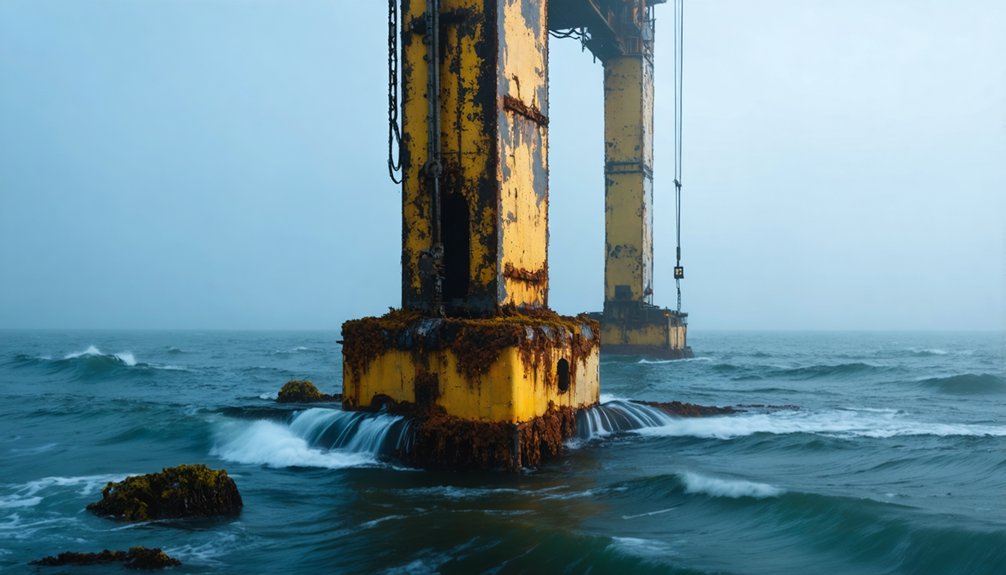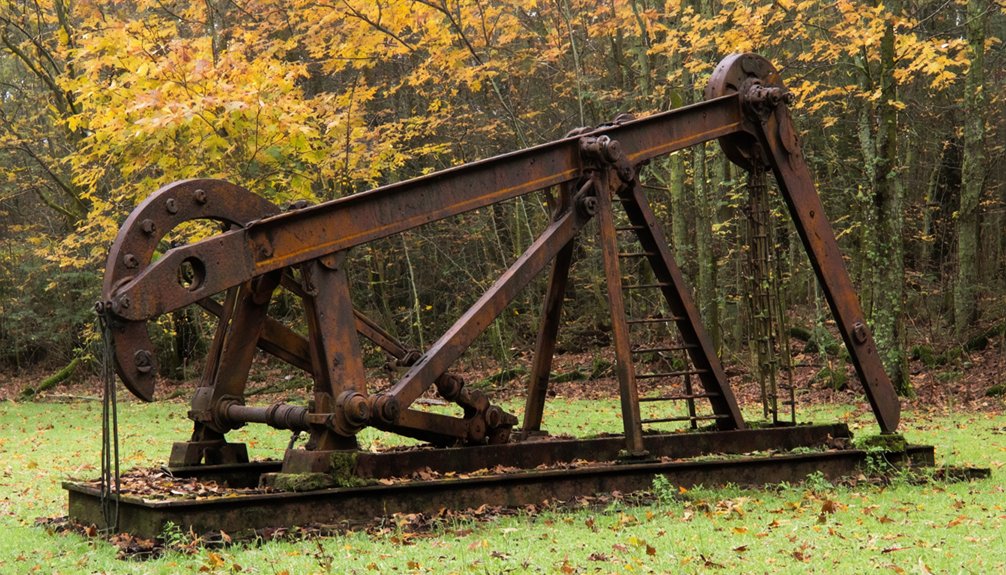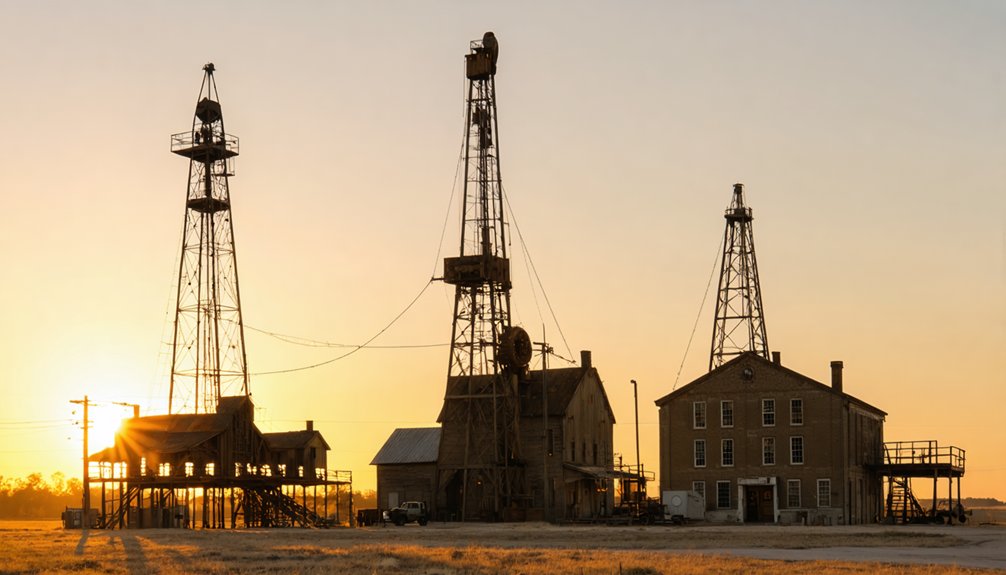You’ll find fascinating industrial ruins to explore at Platform Holly off California’s coast and Norway’s concrete giant Ekofisk Tank. The Permian Basin’s ghost platforms offer glimpses into America’s oil heritage, while the North Sea’s abandoned rigs stand as silent sentinels. Don’t miss Pennsylvania’s historic oil fields, Gulf of Mexico’s underwater sites, or the legendary Brent Spar. Each site tells a unique story of our petroleum past and environmental future. Let these metal giants spark your next adventure.
Key Takeaways
- Terlingua and Lobo ghost towns in West Texas offer accessible abandoned oil infrastructure from the 1920s-1940s with guided paths.
- Platform Holly off California’s coast provides striking views of historic oil operations while serving as a protected marine sanctuary.
- Pecos County, Texas contains over 600 abandoned wells, making it a prime location for industrial archaeology exploration.
- The Ekofisk Tank in Norway stands as a decommissioned concrete marvel, offering unique opportunities to observe marine life adaptation.
- High Island A389 in Flower Garden Banks Sanctuary combines industrial ruins with vibrant marine ecosystems for underwater exploration.
The Haunting Beauty of Platform Holly, California Coast
While Platform Holly stands as a haunting reminder of California’s oil production legacy, its transformation into an unintended marine sanctuary tells a complex story of industrial decline and ecological resilience.
You’ll find this rusty giant two miles off Goleta’s coast, where it’s evolved from a bustling oil operation into a ghost ship on the water.
As you approach by boat, you’ll witness an extraordinary marine habitat where sea lions bask on lower decks and pelicans nest among the weathered pipes and cranes.
The 211-foot structure rises above one of the world’s largest natural seep fields, where rainbow sheens and bubbles still dance on the surface.
Though Platform Holly’s wells are now permanently plugged, its skeletal frame continues to serve as a refuge for diverse marine life, offering a unique glimpse into nature’s reclamation of industrial spaces. Originally constructed in Louisiana and towed to its current location, the platform represents a remarkable feat of engineering from a bygone era. The iconic structure even inspired The Doors frontman Jim Morrison’s song about its crystalline silhouette against the horizon.
Ekofisk Tank: Norway’s Concrete Giant
You’ll find Norway’s pioneering concrete oil storage tank still resting beneath the North Sea waves at Ekofisk, where it stands as both an engineering marvel and a reminder of our industrial impact on marine environments.
ConocoPhillips operates this historic site that continues to be an active field with significant remaining reserves.
Though its topside structures were carefully dismantled with a 98% recycling rate, the massive concrete base remains as a symbol of the challenges of complete offshore decommissioning.
This groundbreaking facility, completed in June 1973, marked the first time concrete was used for offshore petroleum infrastructure.
While you can’t visit the submerged structure directly, its legacy shapes current conversations about responsible resource extraction and the importance of planning for end-of-life infrastructure.
Historical Engineering Marvel
The massive Ekofisk tank, originally designed to store crude oil, underwent significant transformation when a breakwater was installed in 1989 to help protect against powerful wave forces caused by the sinking seabed. Drawing on principles from lighthouse design, the tank’s concrete gravity structure set an important precedent for future offshore platforms.
Environmental Impact Today
The engineering achievements of the Ekofisk tank now face a modern environmental challenge: balancing preservation with ecological responsibility.
You’ll find extensive pollution mitigation efforts have made this concrete giant safer for marine life, with thorough cleaning meeting strict Norwegian environmental standards.
While you explore the area, you’ll notice ongoing ecological monitoring programs tracking any emissions or discharges from the structure.
Norway’s CO2 tax since 1991 helps fund ongoing environmental protection measures at the site.
The decision to leave the tank in place actually cut energy consumption and emissions in half compared to removal options.
Though it remains a massive industrial presence in the North Sea, environmental assessments show it’s having minimal impact on local fishing and shipping activities.
The structure now serves as an artificial reef, creating an unexpected habitat for marine species in these northern waters.
North Sea Safety Legacy
Standing as a proof of engineering innovation, Norway’s Ekofisk Tank pioneered offshore concrete structures in the North Sea during the 1970s.
When you visit this historic site, you’ll witness remarkable safety innovations that revolutionized oil production in harsh marine environments.
The tank’s groundbreaking engineering advancements include:
- A perforated breakwater system capable of withstanding 75-foot waves
- 19 cylindrical storage compartments built with specialized underwater concrete curing
- Innovative mud anchors and hydraulic devices for secure positioning
- Ribbed concrete reinforcement ensuring structural integrity
As the first concrete platform installed in 1973, Ekofisk paved the way for at least 47 major offshore concrete structures worldwide.
Today, while the base remains as a symbol of Norwegian ingenuity, the structure’s partial preservation demonstrates a balanced approach to decommissioning.
You’ll appreciate how this iconic facility shaped modern offshore safety standards while respecting environmental concerns in its final legacy.
The structure was initially constructed in a protected Norwegian fjord before being towed to its final destination.
Ghost Platforms of the Permian Basin
Scattered across 75,000 square miles of West Texas and southeastern New Mexico, the ghost platforms of the Permian Basin serve as stark reminders of America’s complex relationship with fossil fuel extraction.
While these abandoned sites might tempt your adventurous spirit, you’ll need to exercise extreme caution – these ghost platforms pose serious environmental and safety hazards.
The region’s most dramatic indicator of industrial abandonment lies in Pecos County, where over 600 orphaned wells dot the landscape.
You’ll find similar scenes in Reeves and Crockett counties, though many sites are on private property. These decaying sites are part of the nearly $1 billion estimated cleanup burden facing the region.
Before exploring, remember that these wells can leak dangerous chemicals and create hazards like the 200-foot Kelton Ranch sinkhole.
If you’re drawn to these industrial ruins, consider supporting local cleanup efforts instead of risking direct encounters.
The Silent Sentinels: North Sea’s Abandoned Rigs

Deep beneath the churning waves of the North Sea, a massive industrial legacy awaits its final fate as hundreds of aging oil platforms face decommissioning.
You’ll find these silent sentinels scattered across one of Europe’s most challenging marine environments, where decommissioning challenges and marine pollution concerns intersect.
If you’re interested in exploring these industrial giants, here’s what you should know:
- Over 600 production platforms dot the seascape, with half awaiting removal.
- The Brent Delta Platform’s massive concrete base still rests on the seabed.
- The Ekofisk Tank stands as one of the world’s largest abandoned structures.
- Artificial reefs have formed around some platforms, creating unique ecosystems.
While these structures tell a compelling story of industrial heritage, they’re also reminders of our responsibility to restore these waters to their natural state.
Hutton Oilfield’s Industrial Archaeology
While many North Sea oil sites have faded into obscurity, the Hutton Oilfield remains a cornerstone of industrial archaeology that you won’t want to miss.
You’ll find pioneering offshore innovation in the form of the world’s first Tension Leg Platform, a groundbreaking design that changed how we access deep-water oil reserves.
The site’s archaeological significance extends beyond its revolutionary technology.
You’re looking at an engineering marvel that produced up to 50,000 barrels daily during its peak, housed over 100 workers, and showcased the ingenuity of 1980s maritime construction.
The remains of the North West Hutton steel jacket platform tell a compelling story of human achievement in harsh ocean conditions.
For preservation enthusiasts and industrial history buffs, this site represents a vital chapter in offshore energy development.
Forgotten Wells of West Texas

You’ll discover fascinating ghost towns punctuated by rusting derricks throughout West Texas, where nearly a century of oil exploration has left behind thousands of historic production sites.
When exploring these industrial ruins, you’re witnessing both the region’s petroleum heritage and sobering environmental legacy areas, including phenomena like Lake Boehmer, formed by decades of well leakage.
To protect these culturally significant locations while respecting their ecological sensitivity, it’s essential you stay on marked paths and avoid disturbing any equipment or pooled water that may contain contaminants.
Ghost Towns and Wells
Hidden among the arid landscapes of West Texas, historic ghost towns like Terlingua, Lobo, and Sherwood stand as silent witnesses to the region’s oil boom legacy, their perimeters dotted with abandoned wells from the 1920s-1940s.
As you venture into ghost town exploration, you’ll encounter rusted derricks and weathered wellheads that tell stories of Texas’s industrial past.
For responsible abandoned well safety during your visit:
- Carry a gas detector to monitor for toxic hydrogen sulfide and methane
- Stay upwind of visible emissions from wellheads
- Watch for unstable ground and sinkholes near well sites
- Keep your distance from hazardous debris and collapsed structures
Historic Production Sites
Throughout the vast Permian Basin, historic oil production sites from the 1920s-1950s stand as stark reminders of West Texas’s petroleum heritage.
You’ll find these forgotten landscapes scattered across Pecos, Reeves, Ward, and Ector counties, where wildcatters once sought quick fortunes. While exploring these sites, you’ll notice telltale signs of the past: earthen mounds, old cement plugs, and remnants of early drilling operations.
Be aware that these sites require careful navigation. Many wells lack proper documentation, and some pose environmental risks through leaks or potential blowouts.
If you’re drawn to oil heritage exploration, consider joining preservation efforts that use modern technology like drones and magnetometers to map these historic locations. Your discoveries could help document these important cultural landmarks while supporting vital environmental protection efforts.
Environmental Legacy Areas
While historic production sites tell a story of Texas’s oil boom, the environmental legacy of abandoned wells presents a sobering reality in West Texas.
You’ll find stark reminders of our industrial past across the Permian Basin, where thousands of orphaned wells dot the landscape. These silent sentinels serve as essential research areas for understanding groundwater contamination and ecological impact.
When exploring these environmental legacy areas, you’ll encounter:
- Pecos County’s 600+ abandoned wells, the largest concentration in Texas
- Massive sinkholes up to 200 feet wide from subsurface collapse
- Salt-scarred lands where vegetation can’t grow
- Research stations where scientists use drones and methane sensors to track contamination
Brent Spar: A Monument to Environmental Activism

Standing 147 meters tall in the North Sea, the Brent Spar oil storage platform became an iconic symbol of environmental activism in 1995 when Greenpeace’s occupation prevented Shell from dumping the massive structure into the Atlantic Ocean.
You can’t visit Brent Spar today, but its environmental legacy lives on in the policies it sparked.
When Shell planned to sink the platform containing PCBs, heavy metals, and radioactive materials into deep waters, activists scaled the structure and sparked international outrage.
The company’s cheaper disposal option would’ve saved them £22 million, but public pressure forced them to reconsider.
While Greenpeace later admitted overstating the toxic contents, their bold action established a significant precedent: corporations couldn’t simply dump their industrial waste into the oceans without considering environmental impacts.
The Legacy of Piper Alpha
Tragedy struck the North Sea on July 6, 1988, when the Piper Alpha oil platform erupted into an inferno that claimed 167 lives and fundamentally changed offshore safety culture forever.
Today, you can’t visit the physical remains of Piper Alpha, as its steel structure collapsed into the depths. However, its legacy lives on through revolutionary safety reforms that protect offshore workers worldwide.
While exploring abandoned oil sites, remember these sobering lessons:
- A single unsecured valve triggered catastrophic chain reactions
- Maintenance work conflicted with active operations, proving deadly
- Poor communication and inadequate emergency planning cost lives
- The disaster sparked the most thorough offshore safety overhaul in history
The Piper Alpha tragedy reminds us why preserving historical industrial sites matters – they’re powerful teachers of environmental and human safety consciousness.
Historic Oil Fields of Pennsylvania

You’ll discover the birthplace of America’s oil industry at Drake Well, where Edwin Drake drilled the first commercial oil well in 1859, now preserved as a National Historic Landmark with educational exhibits and original equipment.
Just a short drive away, you can witness the world’s oldest continuously producing oil well at McClintock Well Number One, which has been pumping since the 1800s and represents the enduring legacy of Pennsylvania’s petroleum pioneers.
When visiting these historic sites, remember to stay on marked paths and respect the sensitive ecological balance of these preserved industrial landmarks that tell the story of our nation’s energy heritage.
Drake Well Landmark Site
The historic Drake Well in Titusville, Pennsylvania marks the birthplace of America’s commercial oil industry, where Edwin Drake struck black gold at 69½ feet deep in 1859.
While exploring this National Historic Landmark, you’ll discover a thoughtfully preserved slice of oil history that shaped America’s industrial revolution.
When visiting Drake Well, you’ll want to:
- Tour the replica engine house and derrick, built to match Drake’s original 1859 specifications
- Explore 80 permanent exhibits inside the museum that tell the story of petroleum’s impact
- Hike the restored natural trails along Oil Creek, observing the valley’s environmental recovery
- Learn about ongoing preservation efforts and the challenges of documenting abandoned wells
Remember to stay on marked paths, as many undocumented wells still dot the landscape.
McClintock Well Number One
Standing proudly as the world’s oldest continuously producing oil well, McClintock Well Number One has pumped crude from Pennsylvania’s Oil Creek Valley since 1861.
You’ll find this living piece of McClintock history just north of Oil City on Route 8, where it continues its modest oil production after more than 150 years.
While exploring this historic site, you’ll discover the original 15-horsepower Reid gas engine that once powered multiple wells, and learn how early drillers struck oil at 600 feet using “kicking down” techniques.
The well’s fascinating journey through various owners, from Brewer Watson and Company to today’s Pennsylvania Historical Commission, mirrors America’s petroleum story.
As a bonus, the location serves as a trailhead for the Erie to Pittsburgh Trail, letting you combine your industrial history exploration with outdoor recreation.
Gulf of Mexico’s Underwater Graveyards
Deep beneath the Gulf of Mexico’s azure waters lies a sobering industrial legacy: over 27,000 abandoned oil and gas wells, many undocumented and forgotten by time.
For underwater exploration enthusiasts and marine biodiversity researchers, these sites offer both wonder and warning.
Your journey into these underwater graveyards reveals:
- High Island A389, the pioneering artificial reef in Flower Garden Banks Sanctuary
- High Island A376’s crystal-clear waters teeming with corals and pelagic species
- MP 299’s intricate structure, now a thriving marine ecosystem
- Vermilion 171A’s vibrant reef community
While these transformed platforms now support diverse marine life, they remind us of our responsibility to monitor and protect these waters.
The challenge lies in balancing preservation with exploration, as deteriorating seals pose ongoing environmental risks to these accidental sanctuaries.
Frequently Asked Questions
Is Special Equipment Needed to Safely Photograph Abandoned Oil Well Sites?
With 85% of well sites containing explosive gases, you’ll need certified safety gear including explosion-proof cameras, gas monitors, protective equipment and proper permits before attempting any photography tips around these hazards.
What Permits Are Required to Visit These Industrial Archaeological Sites?
You’ll need to file permit applications and follow site regulations before visiting. Contact local authorities, landowners, and tribal councils first – some locations require special access permissions and safety clearances.
Are Guided Tours Available at Any of These Abandoned Locations?
You’ll find guided exploration options at Glen Davis with local expert Graeme, Mentryville through the Historical Society, and LA’s urban wells – each offering unique insights into their historical significance.
Which Seasons Offer the Best Conditions for Exploring These Sites?
Like wildflowers emerging from winter’s grip, spring exploration offers you perfect conditions, followed by fall. You’ll want to avoid harsh winter conditions and summer’s intense heat for best access.
How Close Can Visitors Legally Get to Abandoned Offshore Platforms?
You’ll need to maintain a safe distance according to safety regulations and environmental concerns. While specific distances vary, it’s best to stay beyond navigational safety zones, typically several hundred feet away.
References
- https://grist.org/abandoned-oil-gas-wells-permian-texas-new-mexico/
- https://www.heienergy.org/system/files/hei-energy-brief-4-abandoned-wells.pdf
- https://maritimeducation.com/top-12-abandoned-oil-rigs-giants-left-behind-at-sea/
- https://www.youtube.com/watch?v=tyl9kYS3UDU
- https://www.marineinsight.com/know-more/abandoned-oil-rigs/
- https://www.science.gov/topicpages/a/abandoned+in-situ+oil
- https://www.marineinsight360.com/worlds-abandoned-oil-rigs/
- https://www.science.gov/topicpages/a/abandoned+oil+wells
- https://en.wikipedia.org/wiki/Orphan_wells
- https://worldwidescience.org/topicpages/a/abandoned+oil+field.html



